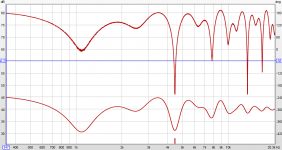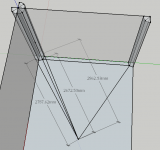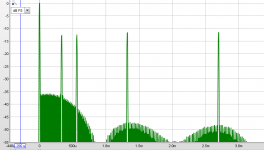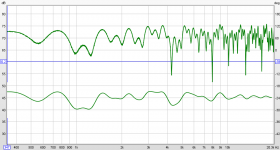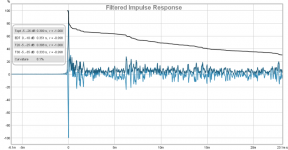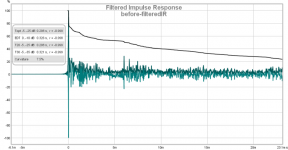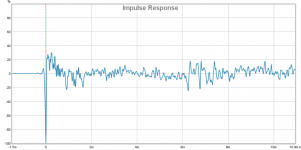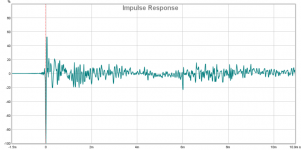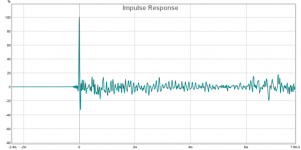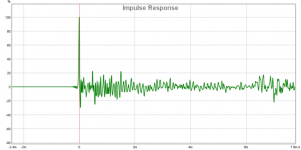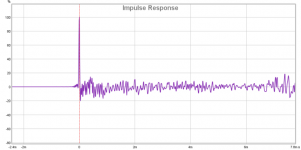The FC, FD and WD versions are all quite different beasts. The FC is the better one obviously.
...
the WD should be significantly cleaner in the upper midrange and the lower treble.
Also consider this, the TC7FD00. It's a better driver than all of the TC6 variations imo
Thanks for those plots! I have tried the TC7 - I bought a pair of every TC driver that PE sells.
IME (and I should one day start a thread just about this, with measurements) the TC series breaks down like this:
TC6Fx00: great dispersion, smooth high end, limited LF. very low HD (500-5k), fairly high distortion below. best midtweeters in TC series.
TC6Fx02: better power / lower HD at the cost of smooth freq response. best midrange.
TC6WD: surprisingly strong response down to 200Hz, better excursion. best value midrange. slightly higher HD than Fx in upper mids.
TC7FD00: like the TC6Fx00 through midrange, yet sounded pretty bright to my ears. not my favorite voicing, maybe a good thing for the line arrays though!
TC8, TC9 except FD18: lowest distortion / better power in low registers, but not a nice fullrange, nasty breakup
TC9FD18: one of the best drivers i've heard! best fullrange (including bass). rather poor dispersion as you might expect which is why I prefer the smaller guys for midtweeter duties. the dispersion might not be as big an issue for the line arrays though.
Subjectively, I don't think the WD is cleaner in the treble than the Fx. Maybe lower in HD, sure, but more and more I suspect the "smeary" sound of my line arrays to be inherent to the WD drivers.. ugh.
As for the difference between the ferrite and neodymium models (FD and FC respectively), I still can't make up my mind. The ferrite seems "more solid / cleaner" while the neo seems "more open / faster". Not sure if I'm just making that up based on their physical properties though.
I did some comparisons between ARC2 corrections and Dirac Live on the line arrays. ARC2 made a big improvement but still the treble seems a bit "off" compared to normal point source speakers. Dirac just sounded horrible, pretty much unlistenable, which is weird because the comparison on Home Theater Shack concluded that they sound about the same...
No DRC yet? I don't think an automated EQ like that could get you what you want/need.
Does ARC produce FIR filters? Might be fun to get the ARC corrected impulse into DRC and let that sort it out further.
I'd love to see FR and IR (first 20 ms) and ETC (first 50 ms) from the ARC attempt. Maybe we could compare it to the Dirac Live and figure out what went wrong.
Does ARC produce FIR filters? Might be fun to get the ARC corrected impulse into DRC and let that sort it out further.
I'd love to see FR and IR (first 20 ms) and ETC (first 50 ms) from the ARC attempt. Maybe we could compare it to the Dirac Live and figure out what went wrong.
Thanks to some discussion on the phantom center thread I have a new theory for why the speakers have a "smeary treble". Perhaps it isn't the drivers, but just the physical property of a corner line array! Quoting myself from that thread:
Half ms delay at -6dB (with some arbitrary EQ on the delay):
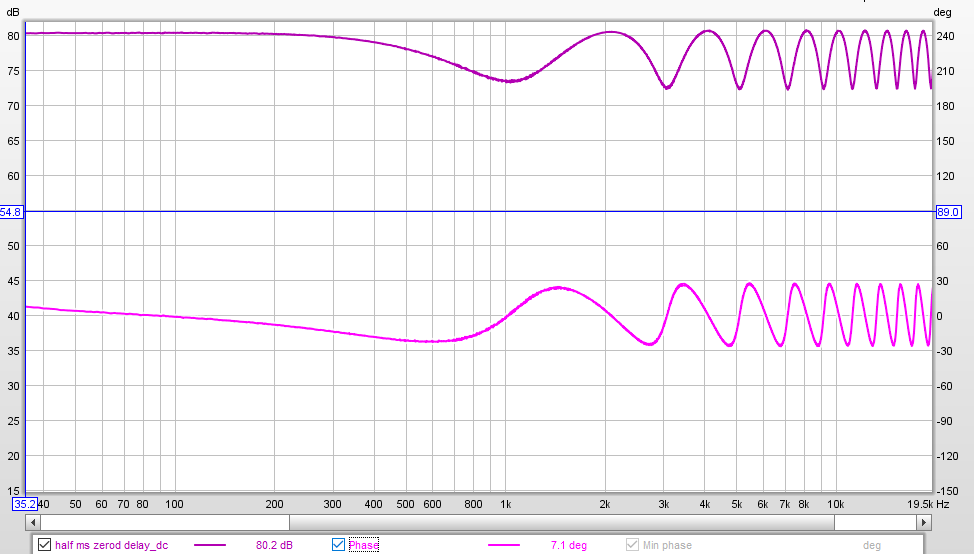
FIR correction could help me out here, recursively cancelling that extremely close reflection from the walls. Unfortunately, side wall and front wall reflections don't reach the listening position at the same time due to the geometry of the corner line arrays. They are pointing into the room at 45 degrees, but the listening position is 60 degrees out from the front corners (equilateral triangle). The plus side is that they are automatically toed in, which improves the stereo sweet spot as noted by Geddes etc. The downside is that the front wall reflection doesn't arrive at the same time as the side wall reflection, making it harder to correct with FIR. I will post a diagram in a minute.
The 0.5ms delay was less noticeable although it still added center weight, perceptually darkening the center since the comb filtering started higher up. Not as much "chorus" effect but still a blurred / smeared treble.
This latter effect of the 0.5ms delay actually made me think about my corner line arrays and why the treble sounds "off". It could be the reflection under 1ms from the corners. Absorbtion right at the corners may solve this.
Half ms delay at -6dB (with some arbitrary EQ on the delay):

FIR correction could help me out here, recursively cancelling that extremely close reflection from the walls. Unfortunately, side wall and front wall reflections don't reach the listening position at the same time due to the geometry of the corner line arrays. They are pointing into the room at 45 degrees, but the listening position is 60 degrees out from the front corners (equilateral triangle). The plus side is that they are automatically toed in, which improves the stereo sweet spot as noted by Geddes etc. The downside is that the front wall reflection doesn't arrive at the same time as the side wall reflection, making it harder to correct with FIR. I will post a diagram in a minute.
comb filtering model for (my) corner line arrays
Did a comb filtering model for my corner line arrays with sketchup, reaper, and REW. Looks pretty nasty really... delayed copies are set to the same volume as the direct sound, which isn't exactly right, but isn't far off either.
Inherent problem to corner line arrays I guess.
First reflections from the side and front walls are 0.3385 ms and 0.5596 ms respectively.
Did a comb filtering model for my corner line arrays with sketchup, reaper, and REW. Looks pretty nasty really... delayed copies are set to the same volume as the direct sound, which isn't exactly right, but isn't far off either.
Inherent problem to corner line arrays I guess.
First reflections from the side and front walls are 0.3385 ms and 0.5596 ms respectively.
Attachments
Last edited:
Modeled up to the 3rd reflection. I'm sure there is an easier way to do this... still using a combination of Sketchup, spreadsheet calculator, reaper, voxengo deconvolver and REW.
The sidewall reflection bouncing around off the front wall (2nd reflection) and back to the side wall (3rd reflection) smooths out the frequency response a bit but man thats a messy impulse response.
Let me know if there is some tool that will simulate this more easily!
The sidewall reflection bouncing around off the front wall (2nd reflection) and back to the side wall (3rd reflection) smooths out the frequency response a bit but man thats a messy impulse response.
Let me know if there is some tool that will simulate this more easily!
Attachments
Instead of a quarter cylinder, would these early reflections be prevented or drastically shortened by shaping the enclosure to become "horn-like"? I am having trouble figuring this out...
<( instead of <)
I believe so, that first one should be a lot smoother <(. The other one <) no doubt has some problems, but damping the transition from ) to < might help.
Can you show an ETC (filtered IR tab in REW) of what's happening right now? The first 20 to 50 ms would do, to see a bit of what the room is doing.
An IR would show the same, just not as clear. Especially the first 3ms need to be clear. Personally I focused on all arrivals within 20 ms.
I think FIR filtering would still help after that. Early reflections need to be dealt with the old fashioned way though. Either avoid, dampen or diffuse... your choice.
Corner absorbtion results
I put up some minimal acoustic treatments today. I don't actually have enough panels to do both channels, so I may go back to my partial-height array (which I think sounds better anyway).
First I put up a diffusor behind my listening position, floor to ceiling basically. Not sure how much difference that made, so I might use the diffusors elsewhere instead.
Next I measured without the 2" absorber panels and then with them.
The comb filtering was very much as predicted in my model without the panels when windowed with FDW to 5 cycles. Adding panels on the sidewall (right in the corner by the line) helped a bit but made it worse in other ways. Adding panels on both the sidewall and backwall smoothed out the frequency response a TON. I can only report that this is essential treatment for corner line arrays.
From top to bottom:
- side wall and front wall treated
- only side wall treated
- no treatment
- simulation of first reflections from side and front wall
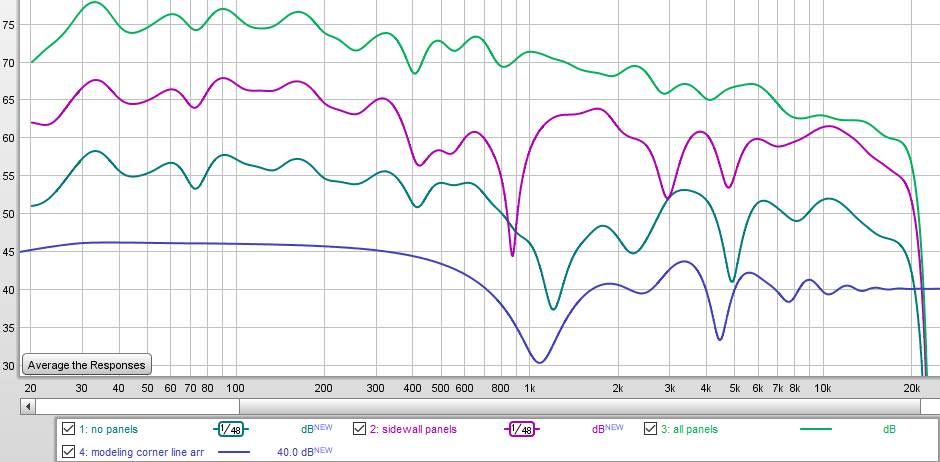
All measurements with the same manual, low-Q EQ. No FIR correction. FDW of 5 cycles. I included the comb filter simulation for comparison.
The "both walls treated" measurement was averaged over a few very close (inch or two) positions since I was getting placement-dependent high frequency nulls. I wasn't getting these nulls without the panels as you can see.. probably because of the corner reflections smoothing out the high frequencies. The HF nulls (which I've averaged out) are not audible.
Strangely, the IR measurements look much worse after the panels than before. Quite a mess really.
I put up some minimal acoustic treatments today. I don't actually have enough panels to do both channels, so I may go back to my partial-height array (which I think sounds better anyway).
First I put up a diffusor behind my listening position, floor to ceiling basically. Not sure how much difference that made, so I might use the diffusors elsewhere instead.
Next I measured without the 2" absorber panels and then with them.
The comb filtering was very much as predicted in my model without the panels when windowed with FDW to 5 cycles. Adding panels on the sidewall (right in the corner by the line) helped a bit but made it worse in other ways. Adding panels on both the sidewall and backwall smoothed out the frequency response a TON. I can only report that this is essential treatment for corner line arrays.
From top to bottom:
- side wall and front wall treated
- only side wall treated
- no treatment
- simulation of first reflections from side and front wall

All measurements with the same manual, low-Q EQ. No FIR correction. FDW of 5 cycles. I included the comb filter simulation for comparison.
The "both walls treated" measurement was averaged over a few very close (inch or two) positions since I was getting placement-dependent high frequency nulls. I wasn't getting these nulls without the panels as you can see.. probably because of the corner reflections smoothing out the high frequencies. The HF nulls (which I've averaged out) are not audible.
Strangely, the IR measurements look much worse after the panels than before. Quite a mess really.
Attachments
-
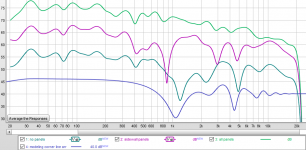 lineArrayLeft-cornerPanels.png69.2 KB · Views: 1,159
lineArrayLeft-cornerPanels.png69.2 KB · Views: 1,159 -
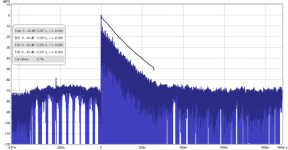 filteredIR-afterPanels.png59.6 KB · Views: 54
filteredIR-afterPanels.png59.6 KB · Views: 54 -
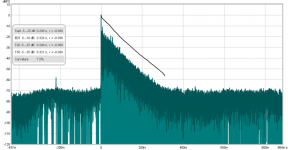 filteredIR-beforePanels.png54.1 KB · Views: 54
filteredIR-beforePanels.png54.1 KB · Views: 54 -
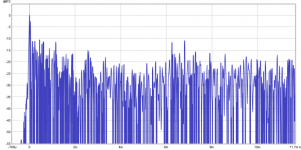 IR-afterPanels.png73.9 KB · Views: 56
IR-afterPanels.png73.9 KB · Views: 56 -
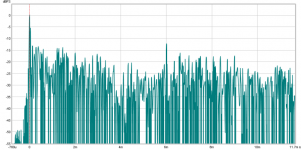 IR-beforePanels.png78.7 KB · Views: 114
IR-beforePanels.png78.7 KB · Views: 114 -
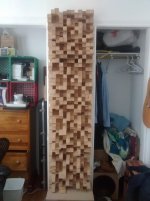 2016-05-09 15.11.56.jpg289 KB · Views: 122
2016-05-09 15.11.56.jpg289 KB · Views: 122 -
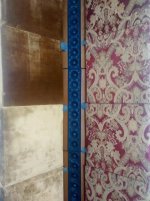 2016-05-09 15.12.31.jpg432.1 KB · Views: 104
2016-05-09 15.12.31.jpg432.1 KB · Views: 104
Last edited:
Any specific reason you plot the IR in dB FS instead of % FS?
The peaks seem to be higher in level, after adding the panels but you've got to keep in mind this type of plot mainly shows what's happening at higher frequencies. It still seems quite restless though, but I'd like to see the % FS IR plots. Just switch it in upper left corner of the graph.
The peaks seem to be higher in level, after adding the panels but you've got to keep in mind this type of plot mainly shows what's happening at higher frequencies. It still seems quite restless though, but I'd like to see the % FS IR plots. Just switch it in upper left corner of the graph.
No I guess I didn't see that option. It certainly makes a lot more sense in %!
I cherry picked this new "after" measurement for one that had a nicer impulse. Seems to vary quite a bit with minor changes in mic placement and EQ settings.
I cherry picked this new "after" measurement for one that had a nicer impulse. Seems to vary quite a bit with minor changes in mic placement and EQ settings.
Attachments
Yes it will vary quite a bit when moving. But this one is easier to judge. Usually I leave the Filtered IR in dB FS, and look at a ~50 ms window there, just to have two quick indications of what's happening. Is the green one pré and the blue one after?
The EQ will probably add a few early peaks. But I'm a bit puzzled by the 0.8 - 1.7 ms peaks. I expect some restlessness after the big peak (pointing down here) but after 0.5 ms to 1 ms it should level out. without any mayor reflections present. At 6 ms you have another reflection which could come from behind the mic?
The EQ will probably add a few early peaks. But I'm a bit puzzled by the 0.8 - 1.7 ms peaks. I expect some restlessness after the big peak (pointing down here) but after 0.5 ms to 1 ms it should level out. without any mayor reflections present. At 6 ms you have another reflection which could come from behind the mic?
Yeah. I dunno. Subjectively, I don't know if I prefer the corner treatments. It's getting more boring (read: dry). Still getting lots of wiggles in the frequency response depending on where I move the mic, even with the FDW.
More impulse responses. Don't know what's causing the weird behaviour around 0.5ms now. Maybe its still corner reflections off of the acoustic panels (they have wood frames). I'm not sure how to read the IRs since they vary so much based on location.
Getting annoyed so I will stop for today.
More impulse responses. Don't know what's causing the weird behaviour around 0.5ms now. Maybe its still corner reflections off of the acoustic panels (they have wood frames). I'm not sure how to read the IRs since they vary so much based on location.
Getting annoyed so I will stop for today.
Attachments
Imagine how boring my impulse must sound! (lol)

There's nothing going wrong here, you're removing the added excitement of the room. But we all like a good room. If you have both speakers boring and firing in time you'll hear it isn't all that boring anymore.
You're still looking at the impulse as if that's the whole story. It isn't. Not the part you see here anyway. The impulse is a chosen rendering of what's happening. Include the STEP and you will see if the timing has improved.
When I first ran FIR correction I heard it as if someone had shrunk my line arrays in size.
All the added excitement seemed to be gone. But after I started working on tonality, with the stereo pair things changed quickly. Don't judge this part alone.
If you're looking for instant gratification, you better stop now. It takes a bit of work and you're well on your way. You decide .
.
Even though the smaller peaks still change depending on location you've got to notice the overall reduction in size. Meaning you've taken away a lot of added reflections already. Plus the general trends in the impulses are the same. The peaks just after 6 ms are shifting depending on mic location. And I bet that wood frame is indeed still reflecting some higher frequencies. Now what do you want to do. Rip off the treatment to get back the added features the reflections bring? The real excitement and/or magic is in the songs.
You're getting closer to bringing that out.

There's nothing going wrong here, you're removing the added excitement of the room. But we all like a good room. If you have both speakers boring and firing in time you'll hear it isn't all that boring anymore.
You're still looking at the impulse as if that's the whole story. It isn't. Not the part you see here anyway. The impulse is a chosen rendering of what's happening. Include the STEP and you will see if the timing has improved.
When I first ran FIR correction I heard it as if someone had shrunk my line arrays in size.
All the added excitement seemed to be gone. But after I started working on tonality, with the stereo pair things changed quickly. Don't judge this part alone.
If you're looking for instant gratification, you better stop now. It takes a bit of work and you're well on your way. You decide
Even though the smaller peaks still change depending on location you've got to notice the overall reduction in size. Meaning you've taken away a lot of added reflections already. Plus the general trends in the impulses are the same. The peaks just after 6 ms are shifting depending on mic location. And I bet that wood frame is indeed still reflecting some higher frequencies. Now what do you want to do. Rip off the treatment to get back the added features the reflections bring? The real excitement and/or magic is in the songs.
You're getting closer to bringing that out.
If you're looking for instant gratification, you better stop now. It takes a bit of work and you're well on your way. You decide.
Even though the smaller peaks still change depending on location you've got to notice the overall reduction in size. Meaning you've taken away a lot of added reflections already. Plus the general trends in the impulses are the same. The peaks just after 6 ms are shifting depending on mic location. And I bet that wood frame is indeed still reflecting some higher frequencies. Now what do you want to do. Rip off the treatment to get back the added features the reflections bring? The real excitement and/or magic is in the songs.
You're getting closer to bringing that out.
Ha! After spending hundreds of hours working on them? I would hardly call that instant gratification.
No, I'm just really surprised how much effort it takes to get these sounding good. I had hoped that various factors would mitigate the need for room treatment:
- corner placement avoiding early front/side wall reflections [nope]
- floor-ceiling line avoiding floor/ceiling reflections [yes, but also causes reverberation problems up top]
- spherical wave widening lateral sweet spot due to slower falloff [nope, image pulls to closer speaker]
I am valuing the simplicity and "easy listening" of wide dispersion point source speakers in-room. In contrast, the corner line arrays are very involved, both in terms of the effort to get them built, set up properly, room treated, and in terms of the listening experience. Kind of like virtual reality, you have to suspend disbelief to enter the "virtual acoustic reality" being presented. The visual disconnect is a big part of this.
I think there is great truth to the statement pos made here:
pos said:The problem with addressing early reflections is that ... the remaining one(s) will become more and more obvious as you go.
I'm right now in the uncanny valley of room treatment, not unlike the uncanny valley with virtual reality or CGI. As one gets closer to an accurate reproduction of the recorded environment, the remaining room artifacts become increasingly troubling. If aiming for the "you are there" experience, be prepared for frustration tracking down each of these artifacts!
Also, whether the "you are there" experience is preferable depends greatly on the source material. So there are some strong arguments against pursuing this goal...
Oh well, I'm already down the rabbit hole.
You've got a point there. But that didn't come as much of a surprise for me.
I only have 3 big panels up, granted, mine are not in the corner. But it worked quite well from the beginning. The time spend figuring out what to do in advance paid off. I had a lot of time between first getting the idea to do it like this, somewhere in September 2011 and finishing the final build in January 2015. I've spend 3/4 of a year after that to optimize the processing. And I'm still playing and learning. That was a key factor for me, learning how this stuff works.
I still have things I want to try out, eventually. My priorities have changed but this still is a rewarding hobby for me. Instead of building all kinds of speakers and repeat I picked one, and went all out. I'm well over hundreds of hours though .
.
I only have 3 big panels up, granted, mine are not in the corner. But it worked quite well from the beginning. The time spend figuring out what to do in advance paid off. I had a lot of time between first getting the idea to do it like this, somewhere in September 2011 and finishing the final build in January 2015. I've spend 3/4 of a year after that to optimize the processing. And I'm still playing and learning. That was a key factor for me, learning how this stuff works.
I still have things I want to try out, eventually. My priorities have changed but this still is a rewarding hobby for me. Instead of building all kinds of speakers and repeat I picked one, and went all out. I'm well over hundreds of hours though
What makes a great speaker in the end more often than not is good ol tuning the system by ear.......measurements and theory alone won't get you there IMO. But you've got to be a really good listener to isolate the problems and listen to your ears as well. I've got a regimen I use that works well for me. First I use good phones and listen in parallel with the phones on and the system playing the same track. This allows for the supplementing low end lost on the phones, the tactile info. I'll take them off and disconnect and then listen to the main system back and forth as a tool. We live sound engineers do this consistently as its really the only way to put together a mix. As a second tool, I'll listen until fatigue begins to set in. At that point, the annoyances of the system become more prevalent.....the audible breakups, sibilance, room modes......all of them begin to really stand out.
IMO, this 'you are there' experience is a bunch of nonsense as in many recordings, there is no 'there'.......it's an artificial assembly of bits and parts with room acoustics added in for good measure. Adele singing in a vocal booth is never gonna sound the same in full on room nor Dave Grohl's drums recorded in a massive studio room won't sound the same in an intimate listening space. If you get the time, read and research Allison......he really understood the above realities and worked with them instead of against. Hope this helps as you sound quite exhausted by all of this. Sometimes the only solution is climb out of the hole and start digging a new one.
IMO, this 'you are there' experience is a bunch of nonsense as in many recordings, there is no 'there'.......it's an artificial assembly of bits and parts with room acoustics added in for good measure. Adele singing in a vocal booth is never gonna sound the same in full on room nor Dave Grohl's drums recorded in a massive studio room won't sound the same in an intimate listening space. If you get the time, read and research Allison......he really understood the above realities and worked with them instead of against. Hope this helps as you sound quite exhausted by all of this. Sometimes the only solution is climb out of the hole and start digging a new one.
What makes a great speaker in the end more often than not is good ol tuning the system by ear.......measurements and theory alone won't get you there IMO. But you've got to be a really good listener to isolate the problems and listen to your ears as well. I've got a regimen I use that works well for me. First I use good phones and listen in parallel with the phones on and the system playing the same track. This allows for the supplementing low end lost on the phones, the tactile info. I'll take them off and disconnect and then listen to the main system back and forth as a tool. We live sound engineers do this consistently as its really the only way to put together a mix. As a second tool, I'll listen until fatigue begins to set in. At that point, the annoyances of the system become more prevalent.....the audible breakups, sibilance, room modes......all of them begin to really stand out.
I worked as a studio recording engineer full-time for several years, mastering for a few more. Still do live sound and mastering occasionally. Agree that listening is important but for loudspeaker development and room acoustics, measurements are also important, provided you understand the relationship between the measurements and what you hear. Certainly, a single microphone doesn't represent what you perceive in your brain, but a lot of research has been done into what measurements *do* predict listening impressions.
I find your headphone technique to be rather strange. But I don't really use headphones for enjoyment listening, mixing, or live sound. Don't think headphones are comparable to speakers in many ways - what you hear at the ears and in the brain is *very* different from headphones to speakers, though the work by Sean Olive has aimed to rectify this in terms of frequency response anyway. I will use headphones to troubleshoot - working on noise reduction, soloing, I assume you are using closed headphones, but the isolation is still far from perfect, so I especially wouldn't trust what's going on in the headphones as a reference. I'm guessing the technique works well for you since you are so used to doing it for live sound, and have developed an internal reference based on the headphones, including bleed. I will try what you are talking about, but would want to mute or low-pass the speakers since I have only open headphones (or in ears). Its an interesting idea. I agree that listening til fatigue - and indeed, noticing how quickly fatigue sets in, will point out the flaws in the system. But also the recording. The two cannot really be separated. And unfortunately, istening to the same batch of reference tracks over and over will surely drive you nuts, no matter how good they sound
IMO, this 'you are there' experience is a bunch of nonsense as in many recordings, there is no 'there'.......it's an artificial assembly of bits and parts with room acoustics added in for good measure. Adele singing in a vocal booth is never gonna sound the same in full on room nor Dave Grohl's drums recorded in a massive studio room won't sound the same in an intimate listening space. If you get the time, read and research Allison......he really understood the above realities and worked with them instead of against. Hope this helps as you sound quite exhausted by all of this. Sometimes the only solution is climb out of the hole and start digging a new one.
Well, it depends on the recording. But for the majority of pop recordings, I agree, they are meant to be augmented by room reflections. Even the controlled-reflection enthusiasts here agree that the stereo sound is improved with some reflections, real or artificially delayed. Surround offers a good shot at real "you are there" reproduction though. In this way, the acoustics of a larger space CAN be reproduced in a smaller room - its the timing of the lateral reflections mainly. However, I have already experienced a much greater "you are there" experience with recordings that have a strong stereo-pair element in the mix, as noted in my original post.
That said, for the majority of material, I'm finding the controlled reflection sound to be inherently more fatiguing than "normal speakers in a normal room". It may soon be time to conclude that it's just not for me. For one thing, the disconnect from reality can be disturbing and I think contributes to listening fatigue. I would assume this to also be the case when delaying the reflections to simulate a "larger stereo listening room" within your room - the disconnect from reality requires a certain mindset that I find fatiguing.
I will look up Allison. Any specific recommendations?
Last edited:
- Status
- This old topic is closed. If you want to reopen this topic, contact a moderator using the "Report Post" button.
- Home
- Loudspeakers
- Multi-Way
- TC6WD (PE buyout) Line Array - Lessons Learned
